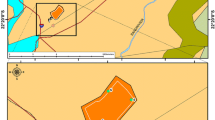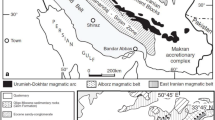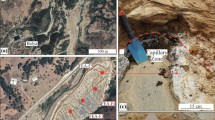Abstract
The Sidi Kamber Zn/Pb mine located 60 km from Skikda is one of the abandoned mining areas of northeastern Algeria for more than 40 years. Currently, this mining area is considered as a real environmental problem. The purpose of this work is to identify and characterize different sources of polymetallic pollution and their impact on the Guénitra dam sediments quality by analyzing the metal content of the weathering products in mine wastes (tailings and waste rock), soil affected by acid mine drainage and Guenitra dam sediments. Moreover, this study aims to determine the mineralogical composition of new compounds occurring in the fine-grained sediments (less than 250 µm) of the mining area. The chemical analysis and the concentration of Fe, Cd, Zn, Cr, Pb, Cu, Mn, Ni, and Hg metals of the studied samples were performed using atomic absorption spectroscopy analysis, inductively coupled plasma optical emission spectrometer, and X-fluorescence ray analysis. The mineralogical composition of all samples was characterized by several techniques such as Fourier transform infrared spectroscopy, X-ray diffraction, scanning electron microscopy, and energy-dispersive spectroscopy. The obtained data were analyzed using multivariate statistical analysis, correlation matrix, hierarchical cluster analysis (HCA), and principal component analysis (PCA). The results showed very high content of Pb, Zn, Cd, Cr, and Hg toxic metals in all samples and suggest taking corrective measures should be taken to reduce the spread of these hazardous elements into the environment. A rehabilitation of the abandoned Sidi Kamber mine should be recommended, as well. The obtained results of HCA and PCA suggest two principal origins of metals pollution: Cu, Mn, Hg, and Pb are derived from anthropogenic sources of mine wastes from the tailings piles, while, Ni, Zn, Cr, and even Fe are derived from lithogenic and anthropogenic sources. Mineralogical characterization results of weathering products in mine wastes, soil, and sediment highlighted the presence of the following minerals: quartz, muscovite, kaolinite, goethite, hematite, lepidocrocite, ferrohexahydrite, and jarosite.







Similar content being viewed by others
References
Acero P, Ayora C, Torrento C, Nieto JM (2006) The behavior of trace elements during schwertmannite precipitation and subsequent transformation into goethite and jarosite. Geochim Cosmochim Acta 70:4130–4139
Aroke UO, Abdulkarim A, Ogubunka RO (2013) Fourier-transform infrared characterization of kaolin, granite, bentonite and barite. ATBU J Environ Technol 6:42–53
Baruah BP, Khare P (2007) Pyrolysis of high sulfur Indian coals. Energy Fuels 21:3346–3352
Baruah MK, Kotoky P, Borah GC (2003) Distribution and nature of organic/mineral bound elements in Assam coals, India. Fuel 82:1783–1791
Beddai OF (1976) Minéralisation de Sidi-Kamber. Rapport N°2, Laboratoire de Géologie appliquée, Université de Constantine
Bigham JM, Murad E (1997) Mineralogy of ochre deposits formed by the oxidation of iron sulfide. Adv Geoecol 30:193–226
Bigham JM, Schwertmann U, Carlson L, Murad E (1990) A poorly crystallized oxyhydroxysulfate of iron formed by bacterial oxidation of Fe(III) in acid mine waters. Geochim Cosmochimica Acta 54:2743–2758
Bigham JM, Schwertmann U, Traina SJ, Winland RL, Wolf M (1996) Schwertmannite and the chemical modeling of iron in acid sulfate waters. Geochim Cosmochim Acta 60:2111–2121
Bouhkalfa C (2007) Heavy metals in the water and sediments of Oued Es-Souk, Algeria, a river receiving acid effluents from an abandoned mine. Afr J Aquat Sci 32:245–249
Boukhalfa C, Chaguer M (2012) Characterisation of sediments polluted by acid mine drainage in the northeast of Algeria. Int J Sedim Res 27:402–407
Choo CO, Lee JK (2002) Mineralogical and geochemical controls on the formation of schwertmannite and goethite in the wetland at Dalseong tungsten mine, Korea. Geosci J 6:281–287
Dudka S, Adriano DC (1997) Environmental impacts of metal ore mining and processing: a review. J Environ Qual 26:590–602
El Amari K, Valera P, Hibti M, Pretti S, Marcello A, Essarraj S (2014) Impact of mine tailings on surrounding soils and ground water: case of Kettara old mine, Morocco. J Afr Earth Sci 100:437–449
Favas PJC, Sarkar SK, Rakshit D, Venkatachalam P, Prasad MNV (2016) Acid mine drainages from abandoned mines: hydrochemistry, environmental impact, resource recovery, and prevention of pollution. Environ Mater Waste 413–462
Gherib A, Djebaili H, Bouchaala L, Charchar N, Aissaoui A, Lehout A (2017) Physiological and biochemical markers in the process of resistance and/or tolerance of heavy metals in the abandoned mining area of Sidi Kamber, Skikda, Algeria. Int J Environ Stud 74:275–289
Hochella MF, Moore JN, Putnis CV, Putnis A (2005) Direct observation of heavy metal–mineral association from the Clark Fork River Superfund Complex: implications for metal transport and bioavailability. Geochim Cosmochim Acta 69:1651–1663
Iakovleva E, Mäkilä E, Salonen J, Sitarz M, Wang S, Sillanpää M (2015) Acid mine drainage (AMD) treatment: neutralization and toxic elements removal with unmodified and modified limestone. Ecol Eng 81:30–40
ICDD (2017) International center for diffraction data. http://www.icdd.com/. Accessed 27 Dec 2017
Jonsson J, Jonsson J, Lovgren L (2006) Precipitation of secondary Fe(III) minerals from acid mine drainage. Appl Geochem 21:437–445
Kalt A, Wey R (1968) Composés interfoliaires d’une silice hydratée cristallisée. Bulletin du Groupe français des Argiles 20:205–214
Kim JJ, Kim SJ, Tazaki K (2002) Mineralogical characterization of microbial ferrihydrite and schwertmannite, and no-biogenic Al-sulfate precipitates from acid mine drainage in the Donghae mine area, Korea. Environ Geol 42:19–31
Kumar A, Maiti SK (2015) Assessment of potentially toxic heavy metal contamination in agricultural fields, sediment, and water from an abandoned chromite-asbestos mine waste of Roro hill, Chaibasa, India. Environ Earth Sci 74:2617–2633
Laurel AS, David BS, Emily RE, Daniel JB, James PS (2014) Sources and fates of heavy metals in a mining-impacted stream: temporal variability and the role of iron oxides. J Sci Total Environ 490:456–466
Louhi A, Hammadi A, Achouri M (2012) Determination of some heavy metal pollutants in sediments of the Seybouse River in Annaba, Algeria. Air Soil Water Res 5:91–101
Lu J, Lu H, Lei K, Wang W, Guan Y (2019) Trace metal element pollution of soil and water resources caused by small-scale metallic ore mining activities: a case study from a sphalerite mine in North China. Environ Sci Pollut Res 26:24630–24644
Lukasz U, Stefan S, Michal S, Branimir S (2011) Clay-mineral formation in soils developed in the weathering zone of pyrite-bearing schists: a case study from the abandoned pyrite mine in wies´ciszowice, lower silesia, SW poland. J Clays Clay Min 59:581–594
Ma L, Sun J, Yang Z, Wang L (2015) Heavy metal contamination of agricultural soils affected by mining activities around the Ganxi River in Chenzhou, Southern China. Environ Monit Assess 187:731
Marescotti P, Carbone C, Comodi P, Frondini F, Lucchetti G (2012) Mineralogical and chemical evolution of ochreous precipitates from the Libiola Fe–Cu-sulfide mine (Eastern Liguria, Italy). Appl Geochem 27:77–589
Medjram S, Malika K (2014) Study and evaluation of risk related to waters contamination of dam of Guenitra, by heavy metals, from mine of Sidi Kamber. J Selcuk Univ Nat Appl Sci, pp 268–274
Navarro MC, Perez-Sirvent C, Martinez-Sanchez MJ, Vidal J, Tovar PJ, Bech J (2008) Abandoned mine sites as a source of contamination by heavy metals: a case study in a semi-arid zone. J Geoche Explor 96:183–193
NF EN 13346 (2000) Caractérisation des boues—Détermination des éléments traces et du phosphore- Méthodes d’extraction à l’eau régale
Oliveira MLS, Marostega F, Taffarel SR, Saikia BK, Waanders FB, Daboit K, Baruah BP, Silva LFO (2014) Nano-mineralogical investigation of coal and fly ashes from coal-based captive power plant (India): an introduction of occupational health hazards. Sci Total Environ 468–469:1128–1137
Oumedjbeur A (1986) Evaluation de la qualité physico-chimique des eaux du bassin versant du barrage de Guénitra (wilaya de Skikda). Thèse de Docteur de 3éme cycle, Université de Savoie
Pérez-Sirvent C, Hernández-Pérez C, Martínez-Sánchez MJ, García-Lorenzo ML, Bech J (2016) Geochemical characterisation of surface waters, topsoils and efflorescences in a historic metal-mining area in Spain. J Soil Sedim 16(4):1238–1252
Rashed MN (2010) Monitoring of contaminated toxic and heavy metals, from mine tailings through age accumulation, in soil and some wild plants at Southeast Egypt. J Hazard Mater 178:739–746
Rios CA, Williams CD, Roberts CL (2008) Removal of heavy metals from acid mine drainage (AMD) using coal fly ash, natural clinker and synthetic zeolites. J Hazard Mater 156:23–35
Rose S, Elliott WC (2000) The effects of pH regulation upon the release of sulfate from ferric precipitates formed in acid mine drainage. Appl Geochem 15:27–34
Rowe RK, Hosney MS (2013) Laboratory investigation of GCL performance for covering arsenic contaminated mine wastes. Geotext Geomembr 39:63–77
Saikia BK (2009) Scanning electron microscopy of Assam Coals, India. J Geol Soc India 74:749–752
Saikia BK, Wang P, Saikia A, Gupta UN, Song H, Liu JW (2015a) Mineralogical and elemental composition of some high sulfur Indian tertiary coals: statistical analysis of the oxides and elements. Energ Fuel 29:1407–1420
Saikia BK, Arpita S, Sahu OMP, Bimala PB (2015b) Study on physico-chemical properties, mineral matters and leaching characteristics of some indian coals and fly ash. J Geol Soc India 86:275–282
Saikia BK, Banashree M, Upendra NG, Sahu OMP, Saikia P, Bimala PB (2016) Mineralogical composition and ash geochemistry of raw and beneficiated high sulfur coals. J Geol Soc India 88:339–349
Silva LFO, Ortiz Fdez-, de Vallejuelo S, Martinez-Arkarazo I, Castro K, Oliveira MLS, Sampaio CH, de Brum Irineu AS, de Leão Felipe B, Taffarel SR, Madariaga JM (2013) Study of environmental pollution and mineralogical characterization of sediment rivers from Brazilian coal mining acid drainage. Sci Total Environ 447:169–178
Singh AN, Zeng DH, Chen FS (2015) Heavy metal concentrations in redeveloping soil of mine spoil under plantations of certain native woody species in dry tropical environment, India. J Environ Sci 17:168–174
Smith B (1999) Infrared spectral intrepretation a systematic approach. CRC Press, London
Tertian R, Claisse F (1982) Principles of quantitative X-ray fluorescence analysis. Heyden
Tian K, Hu W, Xing Z, Huang B, Jia M, Wan M (2016) Determination and evaluation of heavy metals in soils under two different greenhouse vegetable production systems in eastern China. Chemosphere 165:555–563
Tonkin JW, Balistrieri LS, Murray JW (2002) Modeling metal removal onto natural particles formed during mixing of acid rock drainage with ambient surface water. Environ Sci Technol 36:484–492
Van der Marel HW, Beutelspacher H (1976) Atlas of infrared spectroscopy of clay minerals and their admixtures. Elsevier Publishing Company, Amsterdam
Xie Y, Lu G, Yang C, Qu L, Chen M, Guo C, Dang Z (2018) Mineralogical characteristics of sediments and heavy metal mobilization along a river watershed affected by acid mine drainage. PLoS ONE 13:1–17
Zanuzzi A, Arocena JM, Mourik V, Faz Cano JMA (2009) Amendments with organic and industrial wastes stimulate soil formation in mine tailings as revealed by micromorphology. Geoderma 154:69–75
Zhang X, Tian Y, Shen M, Zeng G (2018) Heavy metals in soils and sediments from Dongting Lake in China: occurrence, sources, and spatial distribution by multivariate statistical analysis. Environ Sci Pollut Res 25(14):13687–13696
Acknowledgements
We thank Djareddir Tahar for his great help mostly with sample collection; Djareddir Zohir from Sider El-Hadjar Complex (Annaba) for XRF analysis; F. Djazy, for XRD and FTIR analyses. The authors are also grateful to the GL1K managers and all the team members of the reputable laboratory, especially: Mebirouk A., Balaska N., Brahimi A., and Boucherkha A. Many thanks to Professor Malika Ayadi Trabelsi, Nadjla Chaib, Fares Innal, Riad Bendib, Youghorta Belhocine, and Elbahi Azizi for their help and helpful discussions.
Author information
Authors and Affiliations
Corresponding author
Additional information
Publisher's Note
Springer Nature remains neutral with regard to jurisdictional claims in published maps and institutional affiliations.
Rights and permissions
About this article
Cite this article
Khelfaoui, M., Medjram, M.S., Kabir, A. et al. Chemical and mineralogical characterization of weathering products in mine wastes, soil, and sediment from the abandoned Pb/Zn mine in Skikda, Algeria. Environ Earth Sci 79, 293 (2020). https://doi.org/10.1007/s12665-020-09043-x
Received:
Accepted:
Published:
DOI: https://doi.org/10.1007/s12665-020-09043-x




